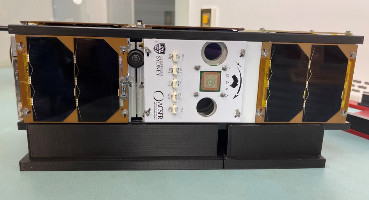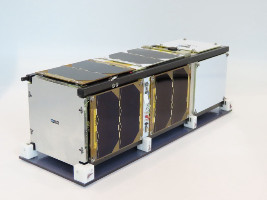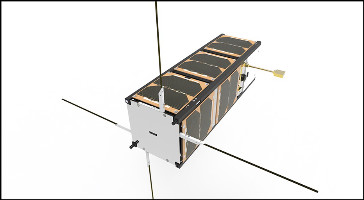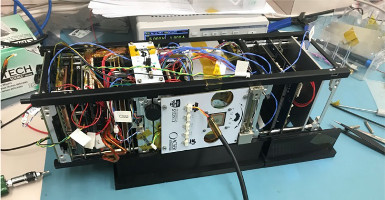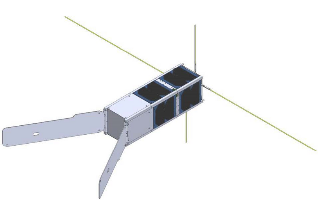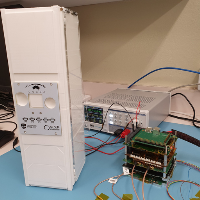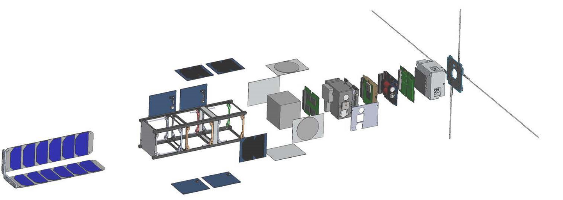| Spacecraft name | CUAVA-1 (Centre for CubeSats, Uncrewed Aerial Vehicles and their Applications) |
|---|---|
| Spacecraft type | CubeSat |
| Units or mass | 3U |
| Status | Reentry 2022-09-02. No signal (No confirmation found as of 2021-12-29 and official website had been quiet after the deployment. SmallSat 2023 presentation) |
| Launched | 2021-08-29 |
| NORAD ID | 49275 |
| Deployer | J-SSOD (JEM Small Satellite Orbital Deployer) |
| Launcher | Falcon 9 (CRS-23) |
| Deployment | Deployed from ISS on 2021-10-06 |
| Organisation | University of Sydney |
| Institution | University |
| Entity type | Academic / Education |
| Country | Australia |
| Operator | Saber Astronautics |
| Launch brokerer | Space BD |
| MCS | Saber Astro PIGI |
| Oneliner |
Educational mission and multiple radio amateur community activities including W-band (76 GHz) transmitter. |
| Description |
Link with the international radio amateur community for outreach, training, and increased data downloads, observe the Earth with a novel multi-spectral imager, use a GPS instrument to explore radio occultation and the reception of GPS signals scattered off the Earth as well as provide a backup determination of the CubeSat location, investigate plasma environment and associated space weather with radiation detectors, and explore the performance of a new communications payload. This mission addresses issues of radio technique interesting to the radio amateur community in the following ways. 1) Global Radio Amateur Participation in Mission and Data Downlinking We will work with radio amateurs and other groups to receive and decode the spacecraft beacon and downlinked data, with subsequent transfer to the internet database (ideally the SatNOGS database). In detail, the CubeSat will transmit data, especially recent images over the terrestrial footprint, to participating radio amateurs across the globe. This will directly involve radio amateurs in the mission and its success, by greatly increasing the overall amount of downlinked data available and having the images be directly relevant to the receiving people. The receiving station and people would be identified in the database and then acknowledged in any publications resulting. The mission’s success will thus be directly tied to the involvement of the international radio amateur community. In addition, the mission should provide multiple opportunities for enhanced outreach and training for both the global amateur radio satellite communities and CUAVA. 2) Student and Radio Amateur Participation in the Groundstation We will train students and desiring radio amateurs in the setup and use of a groundstation hosted by the University of Sydney and then have these people operate the groundstation (including control of the satellite and managing the uplink and downlink) and transfer downlinked data into an internet database (ideally the SatNOGS database). This will involve existing radio clubs in the training, increasing their memberships and leading to new clubs and people familiar with the international radio amateur and satellite communities. 3) Radio Wave Propagation The ionosphere, thermosphere, and lower atmosphere have multiple effects on the propagation and absorption of radio waves and microwaves. This mission will study the electron number density as a function of position, time of day, and space weather events using the ``radio occultation’’ of GPS signals and their associated refraction and attenuation. These data will be published and made available for ionospheric research via a website, and provided to Australia’s Bureau of Meteorology and other space weather organisations worldwide. These data are used to predict maximum and minimum usable frequencies for radio amateurs (and both commercial and government users). In addition, the GPS signal attenuation and electron number density profiles can be used to extract the amount of water as a function of height and used to predict ordinary weather. This work will also add to knowledge of the orbital environment via the drag forces and decay of satellites depending on the gas and plasma densities. 4) Communication Protocols Modulation techniques that will be investigated for the high-speed communications experiment include QPSK, 16-QAM and CPFM. If successful, this technology for wavelengths below 10 cm will increase the data transfer rates by at least 4 orders of magnitude while also decreasing the sizes of antennas and the associated spacecraft. This experiment will be relevant to spacecraft-toground and inter-spacecraft communication links and is particularly relevant to radio amateurs, universities, and their students and staff, due to the dramatic increases in data rates and capabilities and associated dramatic reductions in costs. In addition, the use of multiple frequencies is important for rain (and moisture content) attenuation mitigation techniques, as well as to provide another data stream for weather prediction. 5) Radiation Effects on Electronic Components The Low Earth Orbit (LEO) environment is protected from cosmic rays, solar particles, and particles trapped in the Van Allen Belts by Earth’s magnetic field. Some portions of LEO do harbour regions of enhanced radiation, in the auroral zones and the South Atlantic Anomaly (SAA) for example. In addition, transient solar and magnetospheric particle energization events, a major component of space weather, can change the radiation level by orders of magnitude. This radiation can adversely affect spacecraft which pass through them. This mission will directly measure the counts of energetic particles as a function of space weather activity, position, and time of day, thereby characterising the Earth’s radiation environment. It will also study the effects of the radiation on the computer and other onboard electronics. Examples of effects include single event upsets (SEUs), degraded solar cells, and non-functioning electronics such as radio receivers and transmitters. 6) Attitude and Position Determination Reception and analysis of GPS signals by the onboard GPS receiver will determine the spacecraft’s attitude and location as a function of time, thereby determining the satellite’s orbit. Comparisons with NORAD radar-derived orbits will test the on-board GPS receiver and measure drag and other effects. These orbits are vital for radio amateurs interested in testing and characterising their radio equipment, as well as in downloading the satellite beacon and data signals for transmission via the web to the satellite project and the international community. |
| Results |
As discussed in some of the highlighted failure root causes include:
Some of the risk mitigation strategies are listed as below:
|
| Failure cause | Various theories listed. |
| Sources | [1] [2] [3] |
| Photo sources | [1] [2] [3] [4] [5] [6] [7] |
| COTS subsystems |
|
| Subsystems sources | [1] [2] |
| Keywords | W-band |
| On the same launch |
Last modified: 2024-12-29
